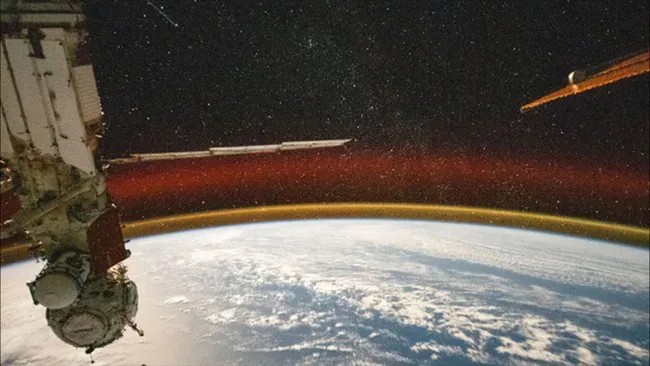Witness the Stunning Gold Glow of Earth’s Atmosphere in a Captivating Photograph Captured from the International Space Station
A new photo taken by an astronaut aboard the International Space Station reveals a golden glow surrounding our planet in a phenomenon known as airglow.
A breathtaking image of Earth’s horizon is revealed in a mesmerizing manner from the International Space Station. The photograph showcases the ethereal airglow, a radiant phenomenon that occurs when sunlight interacts with atoms and molecules in our planet’s atmosphere. Recently shared by NASA on January 21, the picture exhibits a brilliant golden glow gracefully arching above Earth, accompanied by a captivating auburn-colored band set against the backdrop of a starry night sky.
This captivating snapshot was taken at an altitude of 258 miles (415 kilometers) as the space station soared over the Pacific Ocean northeast of Papua New Guinea, as described by NASA. Airglow is a result of the interaction between molecules of nitrogen, oxygen, sodium, and ozone in Earth’s upper atmosphere. These molecules become excited by ultraviolet radiation from sunlight and emit light as they collide with one another. This enchanting display of light is most vividly observed during nighttime. Therefore, the recent photograph was captured with a high exposure, allowing ample light to enter the camera and reveal the beauty of Earth and the celestial expanse.
The International Space Station orbits Earth at a remarkable speed of 5 miles (8 kilometers) per second, completing a revolution around our planet approximately every 90 minutes. During this time, it traverses through 16 sunrises and sunsets, experiencing about 45 minutes of daylight and 45 minutes of darkness in each cycle. Alongside the captivating golden auburn glow, the photograph also captures the delicate wisps of white clouds above the deep blue expanse of the Pacific Ocean. Additionally, glimpses of the space station itself are visible, including the Prichal docking module and the Nauka multipurpose laboratory module, both belonging to Russia’s space agency Roscosmos.
Captured on the left side of the image, Prichal is attached to Nauka, providing five available docking ports to accommodate multiple Russian spacecraft, along with fuel transfer capabilities. The Nauka module — used to conduct experiments as the primary laboratory of the ISS’ Russian segment — arrived at the space station in July 2021, followed closely by Prichal in November 2021.
This article is republished from livescience under a Creative Commons license. Read the original article.
Do not forget to share your opinion with us to provide you with the best posts !




0 Comments